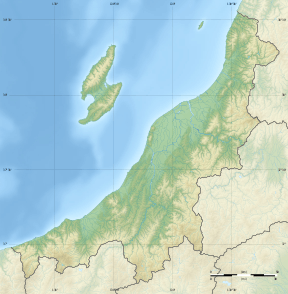Miyaguchi Kofun Group
Miyaguchi Kofun Group (宮口古墳群, Miyaguchi Kofun-gun) is an archaeological site containing three groups of late Kofun period burial tumulii located in what is now part of the city of Jōetsu, Niigata in the Hokuriku region of Japan. The site was designated a National Historic Site of Japan in 1976.[1]
宮口古墳群 | |
 Miyaguchi Kofun | |
 Miyaguchi Kofun Group  Miyaguchi Kofun Group (Japan) | |
| Location | Jōetsu, Niigata, Japan |
|---|---|
| Region | Hokuriku region |
| Coordinates | 37°05′36″N 138°21′27″E |
| Type | Kofun |
| Area | 13199.56 sq meters |
| History | |
| Founded | Kofun period |
| Site notes | |
| Ownership | National Historic Site |
| Public access | Yes |
Overview
The site is located in the Takada Plains of the Jōetsu region of Niigata prefecture, on the alluvial delta of the Inada River. The site was discovered in 1929, and excavation surveys were conducted from 1973. The site consists of three groups of kofun. Site A was found to contain 18 tombs, Site B to the east was found to have eight tombs, and Site C located slightly to the south of Site A was found to have five tombs. All of the kofun were dome-shaped tumuli, and contained lateral burial chambers ranging from 70 to 120 cm in width. Most had a diameter of four to five meters.
Grave goods recovered include Sue ware, straight iron swords, parts of armor, horse fittings and items of jewellery. From these grave goods, it is estimated that these tombs were constructed from the middle of the 6th century to the middle of the 7th century.
The sites are open to the public as an archaeological park, and has a small museum to display some of the artifacts found.
References
- "宮口古墳群" (in Japanese). Agency for Cultural Affairs.
External links
- Joetsu Tourist information page (in Japanese)